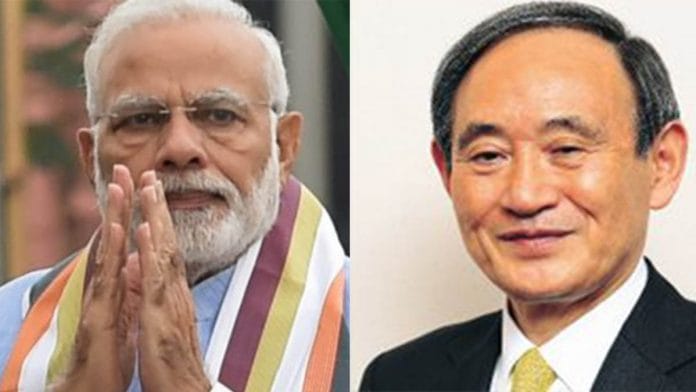New Delhi: India and Japan Friday discussed the upcoming foreign ministers’ meeting of the ‘Quad’ countries — the US, Australia, India and Japan — amid border tensions with China and also decided to conduct a joint maritime exercise.
The matter was discussed during a phone call between Japan’s new Prime Minister Yoshihide Suga and Prime Minister Narendra Modi.
Suga, who replaced former PM Shinzo Abe on 16 September, also held a 30-minute phone call with Chinese President Xi Jinping Friday.
During his conversation with Modi, which lasted for nearly 25 minutes, both sides shared their view to continue to advance the “Japan-India special strategic and global partnership,” according to a statement issued by the Ministry of Foreign Affairs of Japan.
The Ministry of External Affairs also issued a statement, saying: “They emphasised that the economic architecture of a free, open and inclusive Indo-Pacific region must be premised on resilient supply chains, and in this context, welcomed cooperation between India, Japan and other like-minded countries.”
Since assuming charge, Suga has spoken to US President Donald Trump, Australian PM Scott Morrison, German Chancellor Angela Merkel, President of the European Council Charles Michel and British PM Boris Johnson.
Also read: Why India and Indo-Pacific will miss PM Abe more than Japan
Why Quad is important
The meeting of the Quad, also known as Quadrilateral Security Dialogue, is expected to take place next month in Tokyo as Japanese PM wants to signal the priority he accords to the grouping. It was earlier scheduled to be held in India.
The meeting of the Quad is expected to give a major signal to China as it has been created to counter Beijing’s growing military adventurism, diplomatic sources said.
According to the Japan foreign ministry statement, PM Suga said he would like to promote cooperation in multilateral mechanisms with Japan, Australia, India, and the US.
Meanwhile, senior officials from the US, Australia, India, and Japan consulted virtually Friday on collective efforts to advance a “free, open, and inclusive Indo-Pacific region,” said a statement issued by the US Department of State.
“They explored ways to work together in the Mekong sub-region, in the South China Sea, and across the Indo-Pacific to support international law, pluralism, regional stability, and post-pandemic recovery efforts,” it added.
Indo-Japan maritime exercise
India and Japan have also decided to hold a joint Japan-India Maritime Exercise (JIMEX) in which both sides will be conducting various tactical exercises from 26-28 September.
Japan’s Indo-Pacific deployment (IPD) units or warships — JS Kaga and JS IKazuchi — and Indian Navy’s INS Chennai, INS Tarkash and INS Deepak along with P-81 and MiG-29K will be participating in JIMEX.
Earlier this month, before Abe stepped down, India and Japan had signed the crucial Acquisitions and Cross Servicing Agreement, or the Agreement on Reciprocal Provision of Supplies and Services. It was signed between the Indian armed forces and the Self-Defense Forces of Japan to boost the growing defence ties between them.
Also read: Modi’s Japan visit is a window India must use to up its game against China







‘According to the Japan foreign ministry statement, PM Suga said he would like to promote cooperation in multilateral mechanisms with Japan, Australia, India, and the US.’
Unfortunately for India, it shares a border with China which is disputed. India is the weak link in Quad and China will administer another beating, and the other three will not stop China, or even open their mouth.
I would advise Hindus not to be delusional, but be mentally stable, and approach China correctly, through direct negotiations.